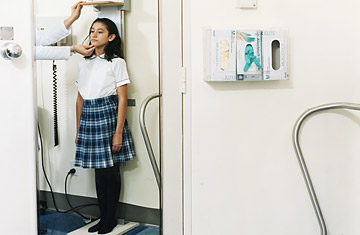
Growth spurts are good — unless they happen too fast and too soon. Then they could suggest premature puberty
(7 of 7)
Parents would thus prefer it if there were some ways to prevent or at least mitigate the problem, and there are--sort of. You can throw out plastic water bottles, microwave your food in glass containers and give your kids wooden toys to play with, but with 6 billion lb. (2.7 billion kg) of BPA produced around the world each year, it's impossible to stay entirely unexposed.
Other sources of trouble are easier to avoid. You can go easy on the soy products to limit your intake of the suspect isoflavones. You can buy hormone-free milk and meat--at least for your kids if not for yourself. And healthy diets and plenty of exercise can help children maintain a normal weight and thus a normal puberty trajectory.
What's more, even when children show symptoms of precocious puberty, it does not always mean the condition will have to be treated. "In many cases, kids don't have much more than precocious pubic hair," says Klein. "Even when girls have true central precocious puberty, 40% of the time we merely watch and wait, as long as they're not psychologically bothered and their adult height is not likely to be compromised." But in the other 60% of cases, when the growth plates in the bones are dangerously close to closing or the condition begins so early that a normal childhood--never mind a full adult height--is unlikely, parents are well advised to act.
The pharmaceutical treatments are the best science can currently offer, but studies under way are trying to determine the genetic roots of precocious puberty, which could go a long way toward explaining the idiopathic cases. One possible answer could be irregularities in what's known as the KISS1 gene, which produces what are known as kisspeptins, key regulators of the endocrine process and cell formation. "Mutations in the gene have been associated with earlier activation of the GnRH neurons," says Klein, "and this may then somehow lead to precocious puberty." Knowing this does not make it easy to re-engineer the gene, but it might at least make it possible to test kids for a KISS1 mutation and monitor the ones who turn up positive for the first signs of trouble.
It's one of the more poignant bits of the precocious-puberty puzzle that a little-discussed risk factor for the condition has been found to be low birth weight. The tinier you are when you pop from the womb, the likelier it is you'll grow up too soon.
"I have a theory about this one," says Herman-Giddens, "and it occurred to me when I was gardening. I've always noticed that the plants at the very edge of the garden--the ones that get the least water and nourishment--are also the ones that begin to flower the earliest." For a plant, flowering is puberty, and hurrying things along is a way of ensuring that even the weakest bud in the bed will have a fair chance to reproduce. For kids, flowering is much more complicated than that, and slowing things down is one way to ensure that it's a safer--and happier--passage.
